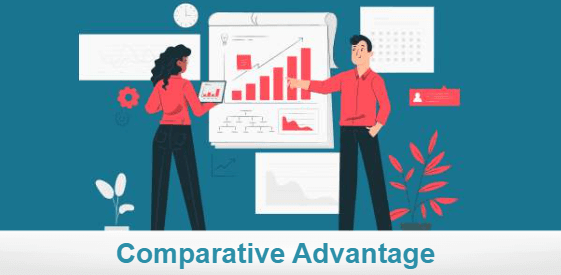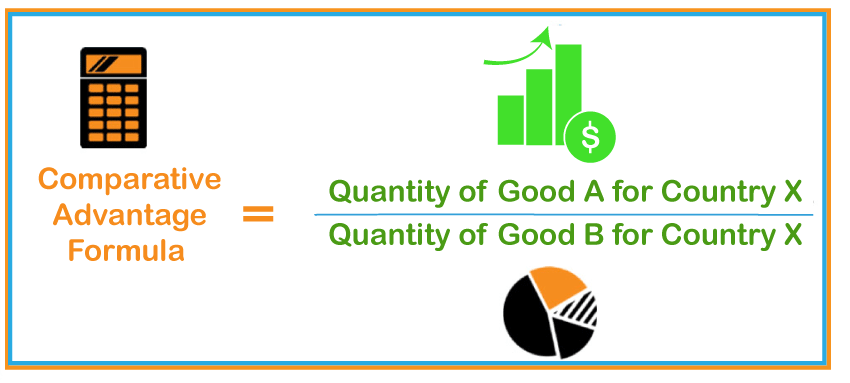What Is Comparative Advantage?Comparative advantage is the ability of an economy to produce a certain good or service at a lower opportunity cost than its trading partners. According to the comparative advantage principle, trade may benefit individuals, countries, or companies. 
In terms of international trade, comparative advantage refers to the products that a country can produce more easily or less expensively than other countries. Even while this frequently demonstrates the benefits of trade, some contemporary economists have come to understand that focusing just on comparative advantages might result in the exploitation and depletion of resources within a country. Comparative advantage legislation is most frequently linked with English political economist David Ricardo and his book "On the Principles of Political Economy and Taxation", published in 1817, even though it is more likely that James Mill, David Ricardo's mentor, created the idea earlier. Understanding Comparative AdvantageOne of the most important ideas in economic theory is comparative advantage, which is a cornerstone of the claim that voluntary cooperation and trade can always benefit all parties involved. Additionally, it is the basis of the theory of global commerce. A thorough knowledge of opportunity cost is essential to comprehending Comparative advantage. An opportunity cost is merely a possible advantage that someone forgoes while choosing one choice over another. In comparative advantage, one company's opportunity cost is lower than that of another since a potential gain has been lost. This form of advantage belongs to the business with the lesser opportunity cost and, as a result, the smallest potential gain that was forfeited. Comparative advantage may also be considered the optimal decision that has given a trade-off. The option with the comparative advantage is the one that offers the greatest overall package when two alternatives are being compared, each of which contains trade-offs (some advantages as well as some downsides). Skills with a Wide RangeThrough salaries, people become aware of their competitive advantages. This compels people to pursue the careers they are comparably most adept in. A good mathematician should practice engineering if it pays better than being a teacher for them and the people they trade with. Greater levels of value creation are possible thanks to more effective labour organization and wider disparities in opportunity costs. The potential for profitable commerce through comparative advantage increases with the diversity of individuals and their talents. Comparative Advantage ExampleScenario 1Think of a well-known athlete like Michael Jordan as an illustration. Famous basketball and baseball star Michael Jordan is a skilled athlete with physical power unequalled by most individuals. Due to his skills and great height, Michael Jordan could paint his house swiftly. Imagine if Michael Jordan could paint his entire house in only eight hours. However, he could also participate in a television commercial filming over those eight hours, which would pay him $50,000. Jordan's next-door neighbour Joe could paint the house in ten hours. He might work in a fast-food restaurant for the same amount of time and make $100. Even if Michael Jordan could paint the home faster and more effectively, Joe has a comparative advantage in this scenario. The finest deal would be for Joe to paint Joe's house in exchange for Michael Jordan filming a television commercial. As long as Joe makes more than $100 and Michael Jordan earns the predicted $50,000, the trade will be successful. Joe and Michael Jordan would undoubtedly agree that this arrangement is ideal for their mutual interests, given their various abilities. Scenario 2High-powered CEOs considering employing an assistant to do certain secretarial duties and answer their emails typically provide an intriguing illustration of comparative benefits. Although the executive may be more adept at handling these tasks than their assistant, the time they spend on secretarial work is better utilized on executive tasks. The assistant is likely less equipped for executive employment even if they are only average at secretarial duties. If they concentrate on their comparative advantages, they are eventually more productive. Absolute Advantage vs Comparative AdvantageAbsolute advantage is in opposition to comparative advantage. The capacity to generate more or better goods and services than competitors is referred to as having an absolute advantage. Comparative advantage is the ability to produce goods and services at a lower opportunity cost, not necessarily at a better volume or quality. Think of an attorney and their secretary to understand the differences. The lawyer can produce legal services more effectively than the secretary, who is also a speedier typist and organizer. In this situation, producing legal services and secretarial labour is completely in the attorney's favour. However, they gain from trade because of their comparative advantages and drawbacks. Assume the attorney generates $175 per hour for legal services and $25 per hour for secretarial assistance. The secretary can complete $20 worth of secretarial work in one hour while providing no legal services. In this case, opportunity cost is important. The attorney must forfeit $175 in revenue due to not being able to practice law but earn $25 through secretarial labour. They lose a lot of money by working as secretaries. They would gain more if they produced an hour's worth of legal services and paid the secretary to type and organize. The secretary's opportunity cost is cheap; thus, they should organize and type for the attorney. It"s where their comparative advantage lies. Opportunity CostUnderstanding the concept of an opportunity cost is essential to comprehend the principle of comparative advantage. The gains forfeited when one alternative is chosen are known as opportunity costs. For instance, a worker can create either one cloth or three wines in an hour of work. Opportunity cost can be conceptualized as follows: What advantage is lost when one cloth or one bottle of wine is produced? Thus, the potential cost of creating one fabric is three wines. The potential cost of creating one wine is one-third of a fabric. Competitive advantage as opposed to Comparative advantageThe capacity of a business, economy, nation, or person to provide consumers with a greater value than its rivals is referred to as having a competitive edge. Comparative advantage is comparable to it, but it is different. The firm must be the lowest-cost supplier of its goods or services, it must deliver superior goods or services than its rivals, and/or it must concentrate on a certain market segment in order to get a competitive edge over others in the same sector or industry. Comparative Advantage in Global CommerceDavid Ricardo is credited with demonstrating how Portugal and England could profit from both commerce and specialization under their comparative advantages. In this instance, Portugal could produce wine at a reasonable price, while England could produce fabric at a reasonable price. Each country would, at last, accept these realities, according to Ricardo, and stop attempting to create the more costly good. 
In actuality, Portugal and England eventually stopped producing cloth and wine, respectively. Both nations realized that it would be in their best interests to stop attempting to produce these goods domestically and start trading with one another in order to obtain them. China now has the edge over the United States in terms of labour costs. Simple consumer goods are produced by Chinese workers at a far lower opportunity cost. The United States has a competitive edge in labour that requires specialized capital. American employees generate high-end products or profitable investment prospects for less money. Both trading in this manner and specializing are advantageous. The notion of comparative advantage contributes to the understanding of why protectionism frequently fails. Followers of this analytical strategy think that nations involved in international commerce will have previously made efforts to identify partners who possess comparative advantages. There may be a local advantage in the form of new employment and industry if a nation withdraws from an international trade agreement, imposes tariffs, etc. This, however, is a short-term answer to a trade issue. As a result, that country would be at a disadvantage relative to its neighbours: countries that were already able to produce these goods at a lower opportunity cost. Arguments against Comparative AdvantageWhy isn't international trade open between nations? Why do some nations continue to be impoverished while others benefit from free trade? It's possible that comparative advantage does not operate as predicted. There are several potential causes for this, but rent-seeking, as it is known in economics, is the most significant. When one group organizes and presses the government to further its interests, rent-seeking happens. Imagine, for instance, that American shoe manufacturers understand and support the free-trade position but are also aware that cheaper imported shoes will harm their particular interests. No one in the shoe business wants to lose their job or see revenues fall in the short term, even if doing so would allow workers to be more productive than if they switched from manufacturing shoes to creating computers. The shoemakers use this motivation to campaign for things like exclusive tax benefits for their goods and higher levies (or outright bans) on international footwear. Even if such protectionist measures ultimately make American workers comparatively less productive and American consumers relatively poorer, there are numerous calls to safeguard American employment and maintain a time-honoured American craft. Benefits and Drawbacks of Comparative AdvantageBenefitsThe rule of comparative advantage is widely applied in international trade to encourage globalization since countries may produce just the things for which they have a comparative advantage and trade those goods with other countries. China and South Korea, two nations that have comparative advantages in specific export-oriented industries, have witnessed large productivity gains by focusing their economies in these areas. By concentrating primarily on jobs or goods that can be produced more efficiently, manufacturing becomes more effective when one uses comparative advantage. Products that need more money or time to create can be obtained from other sources. Total profit margins for a corporation (or a country) will rise when the expenses of less-efficient production are reduced. DrawbacksIn another aspect, over-specialization can sometimes be bad, especially for developing countries. Free trade abuses local labour forces but gives developed nations access to low-cost industrial labour. However, the exploitation of local workforces may have enormous human consequences. Manufacturing can be outsourced to countries with easier labour laws, allowing businesses to benefit from child labour and coercive illegal employment practices that occur in their own country. Similarly, an agricultural nation that primarily concentrates on a few export products may experience soil degradation, resource devastation, and harm to indigenous populations. Additionally, over-specialization has strategic drawbacks since the nation would become reliant on fluctuations in world food prices. Comparative Advantage: Pros and ConsPros
Cons
Who was the founder of the law of comparative advantage?Typically, David Ricardo is credited with creating the comparative advantage law. In 1817, he discussed a theory in "On the Principles of Political Economy and Taxation". However, James Mill, Ricardo's mentor and editor who also published on the topic, may have been the first to propose the concept of comparative advantage. How is the comparative advantage formula determined?The value of the goods that may be produced using the same resources, or opportunity costs, is often used to determine a comparative advantage. The opportunity costs incurred by another economic actor to generate the same commodities are then contrasted with this. 
The formula can be defined as below: Comparative advantage = Quantity of Good A for Country X / Quantity of Good B for Country X For instance, each pair of shoes has a five-belt opportunity cost if factory A can create 100 pairs of shoes with the same resources needed to produce 500 pairs of belts. If competitor factory B can create three belts with the same resources needed to produce one pair of shoes, competitor factory B has a comparative advantage in producing shoes. The Bottom LineIn economics, one of the most crucial ideas is comparative advantage. This concept is central to classical economics and helps to explain why trade and exchange may benefit people, nations, and enterprises more than they do individually. Modern economists have, however, also noted that these profits could be lopsided or lead to the exploitation of the weaker parties.
Next Topic80-20 Rule Definition
|
 For Videos Join Our Youtube Channel: Join Now
For Videos Join Our Youtube Channel: Join Now
Feedback
- Send your Feedback to [email protected]
Help Others, Please Share









